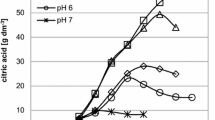Abstract
Serratia marcescens SP511 was previously reported to be anl-proline-producing strain that harbors a recombinant plasmid carrying the mutant type of the proline operon. This strain produced 65 g/L ofl-proline in a medium containing 22% sucrose and urea after 5 d of incubation under the conventional culture conditions. We searched for more suitable culture conditions for more abundantl-proline production by SP511. To improve the supply of a nitrogen source to cells, ammonium was used instead of urea and fed to a culture under control of the pH of the medium. The concentrations of MgSO4 and K2HPO4 were increased, and in addition, sucrose was continuously added to the culture at a final concentration of 32%. Under these conditions, the cell amount was increased twofold over that under the previous conditions andl-proline production reached a maximum of more than 100 g/L after 4 d of incubation.
Similar content being viewed by others
References
Kinoshita, S. (1987),Proc. 4th Eur. Congr. Biotechnol. 4, 679.
Adams, E. and Frank, L. (1980).Annu. Rev. Biochem.,49, 1005.
Baich, A. and Pierson, D. J. (1965),Biochim. Biophys. Acta 104, 397.
Krishna, R. V. and Leisinger, T. (1979),Biochem. J. 181, 215.
Omori, K., Suzuki, S., Imai, Y., and Komatsubara, S. (1991),J. General Microbiol. 137, 509
Komatsubara, S. (1987),Proc. 4th Eur. Congr. Biotechnol. 4, 757.
Kisumi, M., Komatsubara, S., Sugiura, M., and Takagi, T. (1987),CRC Crit. Rev. Biotechnol. 6, 233.
Sugiura, M. and Kisumi, M. (1985),Appl. Environ. Microbiol. 49, 782.
Omori, K., Suzuki, S., Imai, Y., and Komatsubara, S. (1992),J. Gen. Microbiol. 138, 693.
Sugiura, M., Imai, Y., Takagi, T., and Kisumi, M. (1985),J. Biotechnol. 3, 47.
Makoto, M., Takamatsu, S., Nishimura, N., Komatsubara, S., and Tosa, T. (1993),Appl. Biochem. Biotechnol. 37, (in press).
Dubois, M., Gilles, K. A., Hamilton, J. K., Rebers, P. A., and Smith, F. (1956),Anal. Chem. 28, 350.
Kurata, J. and Iwata, T. (1958),KAGAKU NO RYOIKI ZOKAN (in Japanese)34, 53.
Thompson, B. G., Kole, M., and Gerson, D. F. (1985),Biotechnol. Bioeng. 27, 818.
Kole, M. M., Thompson, B. G., and Gerson D. F. (1985),J. Ferment. Technol. 63, 121.
Suzui, T., Yasuda, T., Yamane, T., and Shimizu, S. (1986),J. Ferment. Technol. 64, 1986.
Author information
Authors and Affiliations
Rights and permissions
About this article
Cite this article
Masuda, M., Takamatu, S., Nishimura, N. et al. Improvement of culture conditions forl-proline production by a recombinant strain ofSerratia marcescens . Appl Biochem Biotechnol 43, 189–197 (1993). https://doi.org/10.1007/BF02916452
Received:
Accepted:
Issue Date:
DOI: https://doi.org/10.1007/BF02916452




